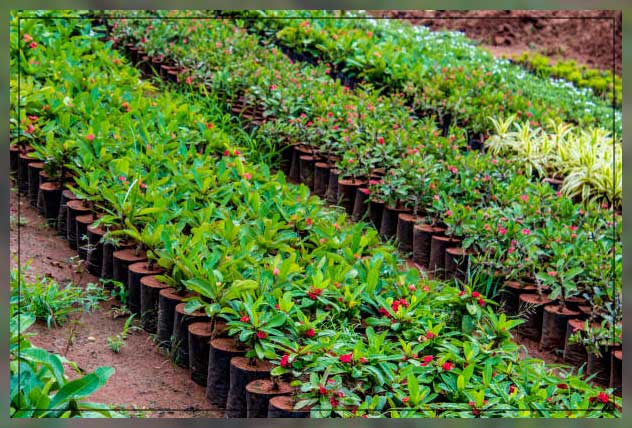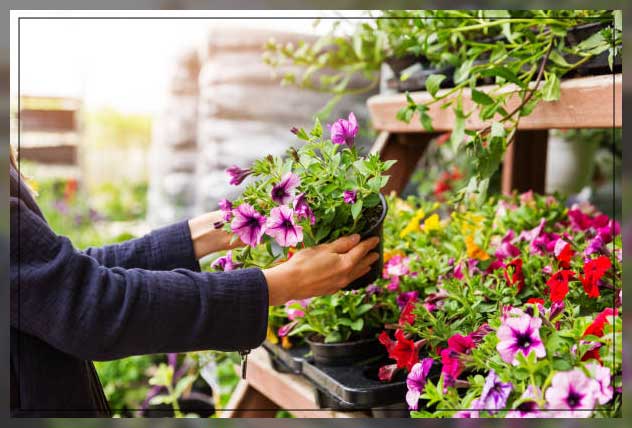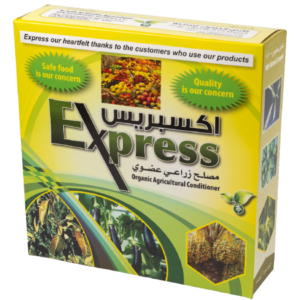As you might have a fair idea, a plant nursery is a portion of agriculture where plants are propagated, grown, nurtured, and sold out to the home garden for commercial purposes. Farmers grow improved quality seedlings in a greenhouse under favorable conditions until they are prepared for planting on a small scale or a big farm.

Young baby plants which are propagated in nurseries can be sold in retail nurseries or even in wholesale nurseries. The sole purpose of all nurseries is to provide young plants or saplings to farms, gardens, agriculture, forestry, and conservation.
What is A Plant Nursery?
A nursery plant center offers its customers different types of young plants that are local or native, imported, and exotic. The customer is generally a home gardener, landscape gardener, or even a commercial farmer.

Remember that a nursery business must cater to various indoor and outdoor plants. Most nurseries today are equipped with all kinds of horticulture requirements. They have all sorts of plant seeds, fertilizers, soil mix, insecticides, garden chemicals, garden tools, and all the necessary items.
Importance of a plant nursery
- Giving the young, baby seedlings special attention is imperative, especially in the first few weeks after germination. Tender and young seedlings grow in nursery beds which are easier and more economical to care for, especially in a small area than in the mail planting field.
- Vegetative propagation is the most common method used in nurseries to propagate fruit crops. Before transplanting propagules in the main field, particular skills and aftercare are necessary. Skilled workers can successfully perform these tasks under controlled conditions.
- Hence it is not easy to raise such plants of these species each year. Gardeners can solve this problem quickly by collecting all the available seeds from years of good seed production. Finally, sowing them in a plant nursery to raise seedlings so gardeners can transplant them in subsequent years.

- The mist house chamber provides the best conditions for hardening grafts and rooting cuttings in a nursery.
- When compared to transplanting of seedlings raised in nurseries – direct sowing is less successful in several crops.
- It is necessary to replace plantation casualties in the same year as the planting or the following year. Due to weed suppression, sowing done in the gaps is often unsuccessful.
Other Key Points
- 1.They will not catch up with plant growth from the original sowing. However, plants grown in nurseries are invariably used to replace casualties. In that sense, nurseries are indispensable. Most farmers generally prefer hardened nursery plants for causality replacement, especially in orchards.
- Furthermore, the nurseries provide more time for pre-planting operations/preparations when seedlings or saplings are raised in the plant nursery.
- It is important to note that a nursery is the only place where seedlings can be hardened against natural elements.
- The seedlings of some species of plants grow very slowly, and if they are sown directly in the main field, they are most likely to become overwhelmed by weeds and later die. For this reason, gardeners raise such slow-growing species in nurseries. After which, they plant them only when weeds are unlikely to damage the seedlings.
- In an effort to artificially regenerate barren and poor farming sites, nursery-grown plants play an important role. They are the most reliable method used to populate such sites.
Types of plant nursery
Broad classification of plant nursery
Plant nurseries – classified into two categories:
A) Home nursery
Typically, as you know, home nurseries are places where plants are grown and raised exclusively to fulfill the specific needs of gardeners.

B) Commercial nursery
Commercial nurseries have a more extensive collection of plants and are often larger. These nurseries are primarily concerned with financial returns.
Types of plant nursery based on the irrigation system
A) Wet nursery
A wet plant nursery has a permanent arrangement of an irrigation system. It means these nurseries are not dependent on rainfall or natural water sources. Any type of plant can be grown in these plant nurseries.
B) Dry nursery
In contrast, dry nurseries are primarily used for growing drought-resistant plants. These nurseries heavily depend on rainfall as they do not have a permanent arrangement of irrigation systems.
Types of plant nursery based on the time span it is used
A) Temporary nursery
In a temporary nursery, gardeners plant seeds in a protected area. Once they germinate, the saplings are transferred to the main field. These nurseries are also known as seed nurseries.
You should prepare these nurseries very close to the primary planting farmland or field. After the planting operation in the main area, these nurseries get disassembled.

Since these nurseries are temporary, they do not have any permanent structures like office space, fixed irrigation systems, fencing etc.
B) Permanent nursery
These nurseries are permanent structures and often made for large-scale operations. These nurseries are made such that they provide saplings and are supplied for the long term. Hence, all these nurseries are equipped with permanent structures. They have fixed irrigation systems, offices, fencing, packaging area, composting area, pot yard etc.
Types of plant nursery based on plantation layout
A) Horizontal nursery
As you may have noticed, most nurseries are horizontal. It means that they cover the whole land area.
B) Vertical nursery
Much like vertical farming, these vertical nurseries have sapling plantation arrangements in multiple levels. Not just the ground.
Types of plant nursery based on enclosure
A) Closed nursery
As the name suggests, the nursery beds are prepared in a closed enclosure such as a greenhouse Dubai or a polyhouse or even a shade-net structure. All these envs have more controlled settings specific to good seedling growth.

B) Open nursery
Open nurseries do not have any roof enclosure, as mentioned above. Crop seedlings are grown in open farmlands with complete exposure to natural elements.
Types of plant nursery based on sales model
A) Retail Nurseries
Gardeners raise plants in retail nurseries for public sale. Generally, these are local nurseries that often sell seasonal plants, ornamental trees, annuals, decor, landscaping, and other landscaping supplies to the general public. In addition, some companies specialize in particular kinds of plants like citrus trees, tropical plants, bulbs, or roses.
B) Wholesale Nurseries
Typically, most of these wholesale plant nurseries grow plants in large volumes – so they can sell them to clients. Retailers, such as garden centers and florists, are common clients of wholesale plant nurseries.
These plants sold by a wholesale nursery might fall into a particular niche, such as vegetables or houseplants. Otherwise, they may be part of a larger assortment, such as vegetables, fruits, or landscaping plants.
C) Private Nurseries
Plants are also grown exclusively for one client in a private nursery. The client can use this plant nursery on a contractual basis. Otherwise, they can be owned by the client. Large estates, institutions, and corporations are often clients of private nurseries.
Key Components of a Plant Nursery
Following are some of the components of a plant nursery
1 . Shed/building structure
Structures include offices, the sales counter, and the packing shed. It also involves the potting shed, the store, and other structures needed for the nursery.
2 . Seed bed
Seed beds are smaller areas when you compare them to nursery beds where the germination of seeds is carried out. Gardeners raise these beds near the office area so that these beds and the germination of seeds are closely monitored.
3 . Progeny tree block
Choices of type and variety of fruit crops and the collection of true-to-type mother plants significantly affect the success and goodwill of a plant nursery.
4 . Propagation structures
The propagation of plants requires structures such as greenhouses, glass houses, hotbeds, poly houses, cold frames, mist houses, and shade houses.
5 . Nursery bed
The plant nursery bed is the plantation area. Sometimes they are at level with the ground, and sometimes they are raised from the level of the ground – especially where the small saplings are grown. They take small saplings from the seed bed. Note that a typical dimension of a plant nursery bed is about three by 1 m wide. Furthermore, they also section the nursery beds, as each section has its crop variety.
6 . Pot yard
The pot yard in the nursery is usually for tender and sensitive plants instead of hardy plants. Gardeners prepare a pot yard in an area with ample shade.
7 . Working yard and packing shed
This place is used by workers – for sorting the saplings. They also use it for packing the saplings before the sale.
To Start A Nursery
Note that you can start a nursery irrespective of where you are located. But you should have sufficient land space to grow plants. Yes, nursery business can be initiated from your backyard, too – in open plots, greenhouses, or agricultural lands.
To start with the business, you must clearly understand what kind of plant species you should develop. Usually, nurseries are located in urban regions. They prefer to grow flowering plants, decorative plants, vegetable plants, and ornamental trees, which people typically buy.
In addition, you should identify the market need as well. Most of the nursery business is highly seasonal. One should start to prepare saplings stocks early so that marketing can be done as soon as the season sets in. Some gardeners at the nursery create a bulk supply of particular varieties. It could be either by seedlings, grafting, or cutting timber trees for forestry. It could also include fruit trees for orchards or edible plants for cultivation. Therefore, we see a plant nursery as a place where young trees or plants are raised for transplanting, sale, or even for experimental study.
Read related topics on sprinkler irrigation, water sprinkler, sprinkler system, drip irrigation, ground water, vegetable farm, cruciferous vegetables, and more.






Leave a Reply